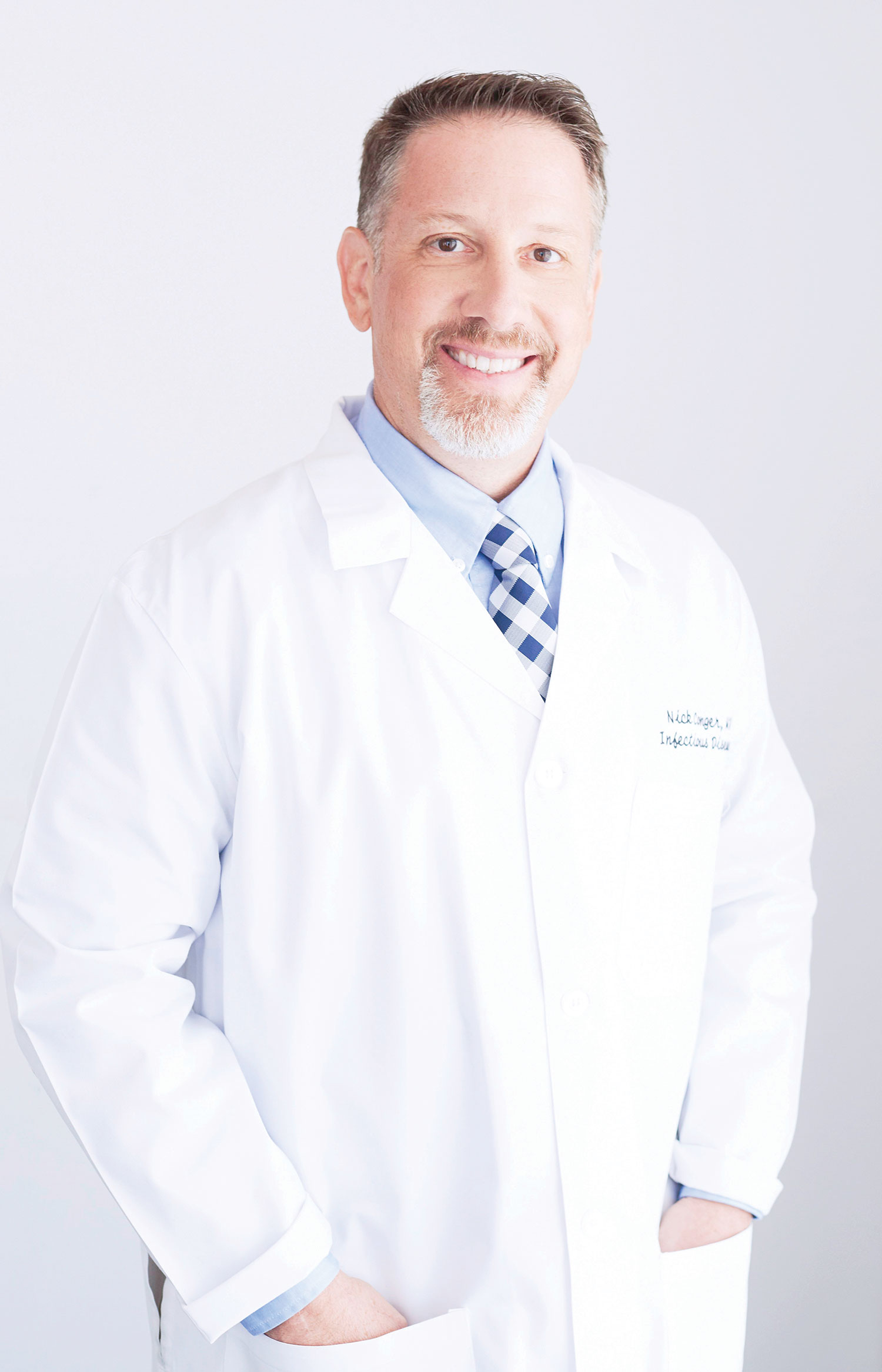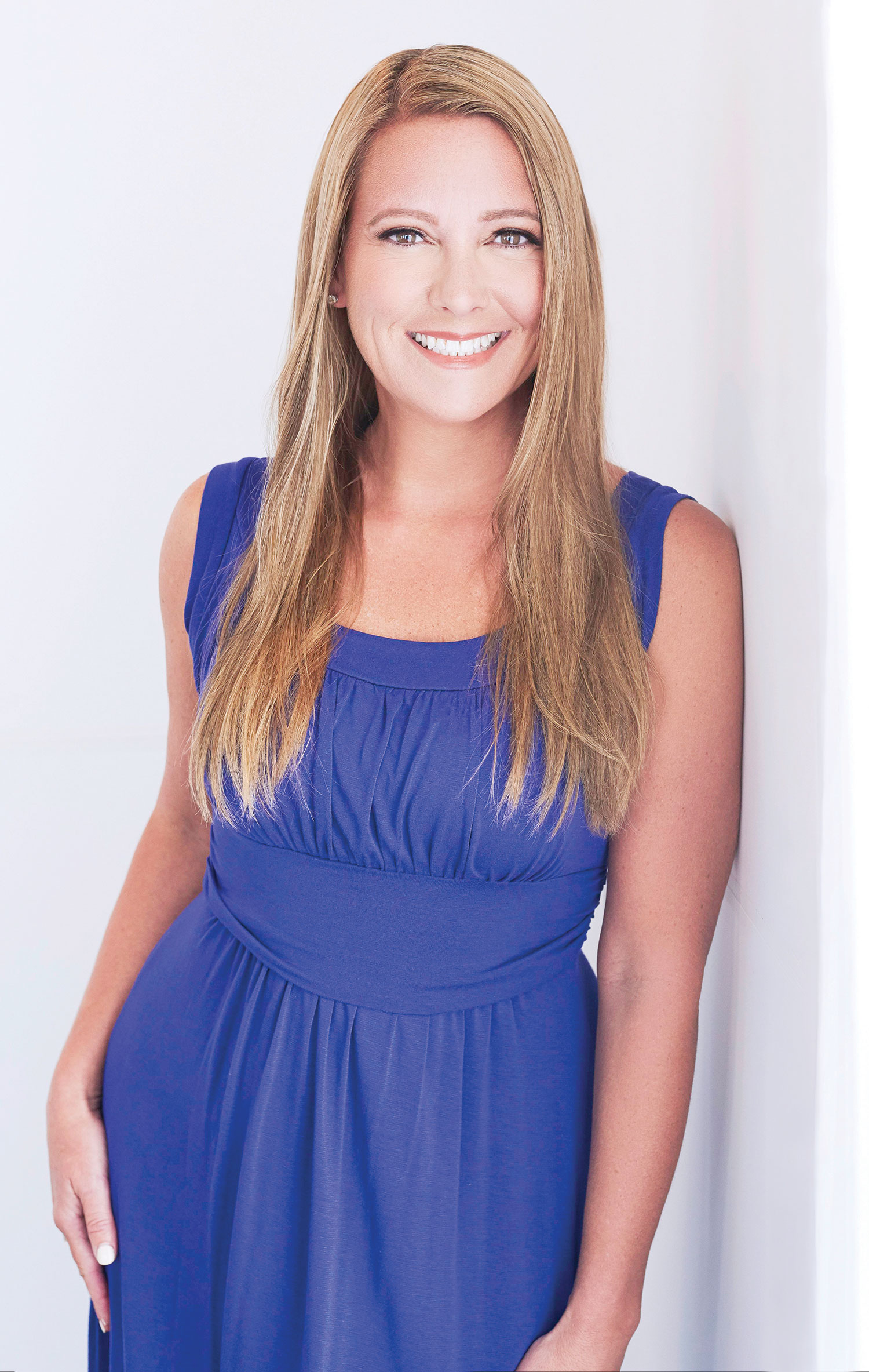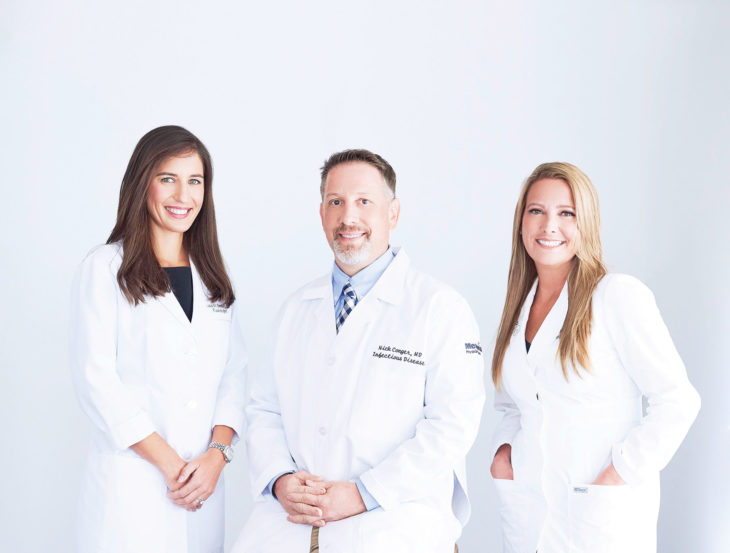
Photography by Brandi Stage Portraiture
Beating breast cancer one screening at a time
Radiologist says we’re making headway against disease

Dr. Lisa Smith has an urgent message for women everywhere: Mammograms save lives.
“Breast imaging is very important, and I truly consider it a privilege doing what I love,” says the radiologist — a partner of GCI Radiology PLLC. “I always try to give my patients the service and compassion I would want my own family and friends to receive.”
The American College of Radiology recommends that every woman receive an annual mammogram starting at age 40. Smith, who also practices at Merit Health Biloxi and at Compass Imaging in Gulfport and D’Iberville, adds her voice to the chorus of experts urging women to get screened.
“Breast imaging is such an important subspecialty within radiology, since breast cancer is the most common type of invasive cancer diagnosed in females in the United States,” she says. “It’s estimated that one in eight women in the U.S. will develop breast cancer in her lifetime.”
As dedicated as she is to her field today, Smith initially shied away from radiology. A fourth-generation doctor, she didn’t want to follow her father and grandfather into their specialty — but it proved to be the perfect fit.
“(After my residency,) I wanted to complete the additional fellowship year in breast imaging because I have always been passionate about women’s health,” says the Memphis native, who has practiced on the Coast since 2017. “I also found the patient interaction and procedures required in breast radiology really suited me.”
Contrary to popular belief, Smith says radiologists don’t spend their days sitting in a dark room in front of a computer. Analyzing and reporting may be an important part of the job, but Smith and her peers devote many of their working hours to consulting with doctors in other specialties and getting face time with patients, often while performing image-guided procedures and biopsies.
Thanks to exciting new technologies and medical advances, Smith says, the field continues to evolve and improve — which includes developments in the fight against breast cancer.
“With advancements in screening mammogram technology, we are sometimes able to detect small breast cancers only a few millimeters in size and early pre-invasive breast cancers,” the radiologist says. “Early detection is allowing more and more patients to make a full recovery, sometimes with less surgery and treatment.”
She notes that within the last two years, state-of-the art 3D tomosynthesis mammography has become widely available on the Coast. Not only does this technology have slightly better cancer detection capability, she says, but it also has a particular benefit for women with dense breast tissue.
Other advances have allowed specialists like Smith to better understand the genetics behind breast cancer.
SMITH’S QUALIFICATIONS
Dr. Smith attended medical school at the University of Tennessee Health and Science Center in Memphis, graduating in 2011. She then moved to Birmingham for her radiology residency at the University of Alabama-Birmingham, which she completed in 2016. Upon finishing her residency, she completed a breast-imaging fellowship at Emory University in Atlanta.
“We are now able to identify and test for a number of breast cancer gene mutations …,” she says. “The combination of risk-assessment models with genetic testing allows us to select those who qualify for annual high-risk screening breast MRIs, which are also now widely available on the Coast.”
Patients who qualify include those with a 20-25 percent lifetime risk of breast cancer based on family history, gene mutation, or having a first-degree relative with a gene mutation. The National Cancer Institute offers a free risk-assessment tool at http://bcrisktool.cancer.gov/.
As breast cancer breakthroughs happen, Smith gets a front-row seat to how they affect patients.
“Like most of my colleagues, the desire to make a difference and help people was a big part of my decision (to become a doctor),” she says. “The lifelong learning required in medicine also attracted me to the field.”
As an adjunct professor, through her practice affiliation with the University of South Alabama, Smith shares her knowledge with residents once a month. As a physician, she’s committed to treating patients with respect and kindness — which includes giving in-person, same-day results to women who come for a diagnostic breast workup after a mammogram.
“Quality care starts with an entire team of dedicated staff and clinicians,” she says. “It is a team effort.”
On her free time, Smith belongs to another team — a tennis squad that won the state championship last year. She’s also a wife to Chris Smith, a local attorney, and mom to a 14-month-old son, Harrison.
“Since having my first child, I have gained additional respect for working parents,” she says. “Having a good work-life balance is so important to both achieving and maintaining professional success.”
Fighting on the invisible battlefield
COVID-19 poses latest challenge for infectious disease specialist

Dr. Nicholas Conger finds infectious diseases fascinating.
“It is an ever-changing field with new and emerging infections always on the horizon …,” he says. “For me, it incorporates a perfect blend of science and art, as not all of the answers are found ‘in the books.’”
While those answers can be elusive, Conger enjoys the search — and the constant learning that medicine demands. An infectious disease specialist with Memorial Hospital in Gulfport, he retired from the U.S. Air Force in 2018 after 21 years of active duty service and returned with his family to the Coast.
During his service, Conger witnessed several situations while deployed that have stayed with him. One badly burned orphan was flown to the U.S. for treatment and ultimately was adopted. Service members held another child in traction until bullets and fragments within millimeters of her spine could be removed. Multiple blast victims received immediate craniectomies and somehow survived.
Conger’s specialty represents a different battleground — or as the doctor would describe it, more like a puzzle.
“Practicing infectious diseases often involves matching the best treatment for a given infection, for the right amount of time, to help the body overcome an infection while causing the least side effects or harm to the patient,” he says. The challenge makes the job fun and intellectually stimulating, he adds — “and, of course, very satisfying when patients overcome their infections.”
CONGER’S CREDENTIALS
Dr. Conger holds a bachelor-of-science degree in biology from the University of Dallas in Irving, Texas, and attended medical school at the University of Texas at Houston. After joining the U.S. Air Force, he completed an internal medicine internship and residency training at Wilford Hall Medical Center in San Antonio at Lackland Air Force Base, followed by a two-year infectious diseases fellowship training there. He was a staff physician at Wilford Hall for nine years, at Landstuhl Regional Medical Center in Landstuhl, Germany, for four years, at Keesler Medical Center for four years and at Wright-Patterson Medical Center in Ohio for four years.
Infectious disease specialists like Conger are consulted for various reasons, from difficult-to-treat, drug-resistant infections to chronic infections that require ongoing care. They treat patients with conditions like HIV, hepatitis B, and hepatitis C, as well as acute bacterial infections like MRSA, and they work with orthopedic surgeons to cure patients when they have infected joints and bones.
“In addition, we often are sent patients who have fevers of unknown cause,” he says, “or other symptoms that suggest they have an infection where further investigation is needed.”
Conger learned of COVID-19 like everyone else — through news and media reports. Early on, some alarm bells rang in infectious disease physician forums, the doctor recalls. The danger became clear when cases started popping up in numerous countries.
“This was clearly different than the first SARS virus, which was mostly contained within Asia and only had an outbreak outside of Asia in Toronto,” Conger says. “It became quite evident that this virus was much more contagious, and the general population was largely not immune, which could lead to widespread transmission and many deaths.”
Conger’s background makes him uniquely suited for the present pandemic. During his stint in Germany, he cared for a patient with Crimean Congo hemorrhagic fever, an infection similar in severity and contagiousness to Ebola. Also while in Germany, he was among those to treat an American citizen who came into the hospital emaciated from a treatable viral infection he’d ignored for years.
When it comes to COVID-19, Conger acknowledges that many unknowns remain. He and other experts aren’t sure why the virus has a relatively minimal effect on children, or why it has broken the mold for respiratory viruses and not relented during the warm summer months.
The range of symptoms and severity is puzzling, too.
“There are clearly risk factors that make some more ill than others,” Conger says, “and we have just begun to scratch the surface trying to understand why.”
Although he’s watched some COVID patients sustain permanent damage and others succumb to the illness, Conger insists “it’s not all doom and gloom.”
“We have seen many patients improve and do quite well,” he says. “Expanded testing has shown that there likely large groups of people, particularly the young and healthy, that have few to any symptoms and do quite well when infected.”
Convalescent plasma, or immune cells, from people who have recovered from COVID-19 has proven helpful, Conger says, as have steroids like dexamethasone. The antiviral drug Remdesivir has been shown to decrease illness duration, and potentially mortality, and others are being studied.
“In addition, we have heard of some potential vaccine candidates,” he says. “As of right now, it is really difficult to predict if and when a vaccine will be available and how effective any given vaccine will be.”
The doctor decries the many misconceptions about COVID, as many reports either dramatically overstate the dangers or dismiss it as nothing to fear. Like most things in life, he says, the truth lies somewhere in between.
“In my opinion, policy makers should take advantage of what we know about the epidemiology of this infection: that the elderly and those with significant medical problems are clearly at highest risk of severe infection and death,” he says. “Protecting them should be the cornerstone of any program moving forward, while still allowing for the most, yet safest, freedom of movement, education and commerce for those at lower risk.”
Recent events have reinforced why Conger — a husband and father of five — entered his field. The practical application of knowledge is one of his favorite aspects of medicine.
“Most importantly,” he says, “I love the daily interactions with patients and the relationships that develop in an effort to bring healing to our community.”
Giving every patient her best
OB-GYN delivers care with kindness, empathy

Before entering an exam room, Dr. Alisha Ware pauses for a moment to clear her mind — preparing to give her all to the woman waiting for her.
Ware, an OB-GYN and a partner with The Woman’s Clinic PA, may see dozens of patients on any given day, but the last will receive as much attention and compassion as the first.
“Empathy is very important in my job,” Ware says. “Being able to truly put yourself in someone else’s place and understand what they must be feeling is important every day with every patient.”
Ware had no other physicians in her family and didn’t always want to be a doctor. She had a talent for math and science, so she started at Louisiana State University studying civil engineering. After a semester of basic courses for her major, she realized she was in the wrong place.
“I needed to be able to talk to people; I needed more interaction,” Ware says. “I also found I enjoyed life sciences far more than other subjects. Medicine felt like it would be a good place to bring all of that together.”
When she went to medical school at LSU, Ware thought dermatology might suit her, but she fell in love with OB-GYN — largely due to the obstetrics side. She gets to be part of a woman’s life at a very joyful time and help ensure the best outcome for mom and baby.
“I take that responsibility so seriously,” Ware says, “but there is so much pleasure in watching my patients become parents.”
For Ware, nothing beats delivering babies. One memorable patient was in labor for 38 hours and birthed her twins vaginally without medicine. She also delivered a child for a fellow physician — radiologist Dr. Lisa Smith.
“Every time I do a delivery, there is always a moment when I look, right as the baby is crowning, and I think, ‘This process just doesn’t look like it should work’ — but it does,” Ware says. “The whole process is so amazing that even after hundreds, maybe thousands, at this point, I never get tired of it.”
On the gynecology side, patients may be anxious, and Ware makes every effort to calm their nerves. The doctor says the best thing she can hear is a patient telling her that coming to her office was easier than expected.
WARE’S EXPERIENCE
Dr. Ware holds a bachelor-of-science degree in biochemistry from Louisiana State University in Baton Rouge. She attended medical school at LSU in Shreveport and received an M.D. in 1999. Ware also completed her OB-GYN residency at the LSU Health Sciences Center in Shreveport from 1999 to 2003. She practiced in Shreveport from 2003 until she moved to the Gulf Coast in 2011.
“I enjoy taking care of women,” Ware adds. “I enjoy creating a place that they can ask the uncomfortable questions. I always hoped that an approachable demeanor and genuine interest in patients would create that.”
Thanks to significant advances, Ware and her peers have more tools than ever to help those who depend on them. When Ware started medical school, the most common cause of abnormal pap smears was just becoming clear. Since then, according to Ware, 100 percent of HPV types have been sequenced, and experts have learned which subtypes are most likely to lead to cancer. An HPV vaccine has been developed as well.
Overall, pap smears have become more sensitive and specific, she adds, and aren’t required nearly as often due to better technology. However, this doesn’t mean patients should skip visits to the gynecologist’s office.
Many of Ware’s patients don’t see any other doctor regularly, so even if they’re not coming to her for a pap smear, she says, someone still needs to check their blood pressure, review changes in their medical history, schedule screenings and provide other basic care.
“It’s amazing the number of things that are unexpected that can be found on otherwise routine physicals,” Ware says. “Once an abnormal finding on a routine pelvic exam turned out to be the only finding that led us to discovering (a patient’s) lymphoma.
“Obviously, such situations are rare — but if you don’t go, we don’t know.”
Knowledge and skill matter greatly in her field, but Ware says an ability to relate to patients is essential, too. OB-GYNs may deliver more babies than bad news, but the misfortune Ware sees still breaks her heart.
“I think what keeps all of us in my specialty going during those times is knowing that the patient needs you, needs you to handle her situation with empathy and give her the confidence that she is going to be OK,” she says. With a family of her own, Ware is just like every other working mom — trying to decide what’s for dinner when she gets off work. Her husband, a general surgeon at Memorial, can identify with the challenges of her job, and her three children have taken its demands in stride.
“Though it wasn’t always easy, they’ve always grasped the idea that patients have to come first,” Ware says. “I hope growing up with that notion always helps them remember that there’s something bigger than themselves.”



